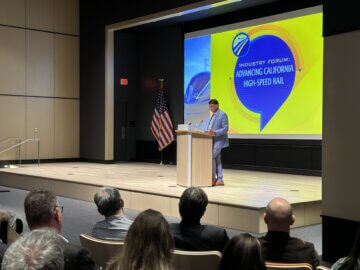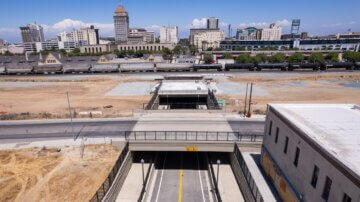|
Major News |
Partner Updates |
Outreach Updates |
California Moves Forward with Steady Funding Agreement for High-Speed Rail

Governor Newsom speaks at the signing ceremony for the legislation that extended California’s Cap-and-Invest program.
On September 19, Governor Gavin Newsom signed an agreement negotiated with the state Legislature to reauthorize the Cap-and-Invest program and provide a historic commitment of $1 billion for the California High-Speed Rail Authority (Authority) annually through 2045. This is the largest guaranteed infusion of funding secured for the program to date.
CEO Ian Choudri called the agreement “a big, bold statement about California’s future — one that will create jobs, cut pollution, and connect and transform communities across the state.”
This will provide the high-speed rail project with a stable and predictable funding stream, allowing for planning with greater certainty and more efficient project delivery. The guaranteed funding also improves the project’s ability to attract private capital and leverage existing funds up front, accelerating delivery and lowering long-term costs.
This minimum funding level and 15-year extension would cover the costs to build the Merced to Bakersfield segment in the Central Valley, effectively closing any gaps in funding.
Read more about this funding here.
CEO Ian Choudri Shares New Vision for High-Speed Rail in First Year
In August 2024, the Authority’s Board of Directors approved the selection of Ian Choudri as the program’s new CEO to transition the program from planning to operations. Since then, he has restructured the Authority to run more like a business, ensuring efficiency, accountability, and faster execution. In his first year, CEO Choudri has engaged with transportation stakeholders and local partners up and down the state on the new direction for the program. With these changes, CEO Choudri is also attracting support and interest from audiences around the world, including the private sector, by demonstrating the Authority is on a bold new path to delivering faster, smarter, and more economically. Here’s a quick look back at some of the highlights:
To kick off 2025, the Authority hosted a highly successful two-day industry forum with more than 400 participants representing rail systems, construction, design, technology, and finance firms. Experts and innovators traveled from all over the country, and some internationally, to meet with the Authority and give valuable feedback to help inform critical decisions and shape the future of the project. The Authority continues to seek feedback and advice from the private sector as we inform our procurement strategy going forward, including the issuance of a Request for Expressions of Interest this spring regarding the commercial, financial, technical, and procurement aspects of a preferred delivery strategy for the high-speed rail project.
In May, CEO Choudri appeared on the national stage in Washington, D.C., at the U.S. High Speed Rail Association’s Annual Conference. His presentation, “Advancing America’s First True High-Speed Rail System in the Southwest,” covered the progress made toward his goals for the program, and agreements with Brightline West and the High-Desert Joint Powers Corridor to connect our high-speed rail system with theirs to create the first interstate high speed rail network in the country.
In June, CEO Choudri was a featured speaker at the American Public Transportation Association’s High-Speed Rail Seminar in San Francisco. Alongside executives from development and investment firms, he participated in the panel “Public Private Partnerships and High-Speed Rail” for an international audience of passenger rail professionals. The panel discussed the benefits P3s can bring to help deliver program segments faster and more efficiently while commercializing assets such as trainsets, station facilities, track access, fiber, and real estate.
CEO Choudri has also been talking with members of the media up and down the state about the next steps for high-speed rail both at the local level and in the state as whole. Recent articles in the San Jose Mercury News here and here, positive editorial pieces in the Fresno Bee here, here, and here, and long-form articles in Forbes, KTLA, Streetsblog, and the San Francisco Chronicle demonstrate Choudri’s commitment to share the reimagined direction of the project with the public.
With new leadership comes a new vision for high-speed rail. CEO Choudri has traveled across the state and the country, engaging the public, the media, and critical stakeholders to communicate that innovative vision. With renewed energy and fresh perspective, the program is marching onward to deliver a modern, clean transportation system for all Californians.
Authority Accelerates Timeline for 2026 Rail Installation
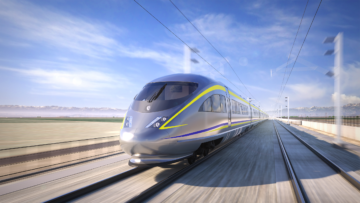
With track and systems construction slated to begin next year, progress on California High-Speed Rail shows no signs of slowing down.
On August 28, the Authority Board of Directors approved issuance of invitations for bids for the provisions of high-speed rail track and other required system components, a major milestone that accelerates track and systems construction, slated to begin in the next year. This approval opens the door for American manufacturers to competitively bid in six separate procurements, just as the Authority nears completion of its southern railhead project in Kern County.
Materials needed to lay track along the 119-mile segment will be 100 percent state-funded and include several commodities, including rail, ties, overhead contact system poles, fiber optic cable, and EN ballast, with a total approved cost of $507 million spread over multiple anticipated contract awards. All materials will be newly manufactured and compliant with the Buy America and the Build America, Buy America Act. Invitation for bids is scheduled to begin on or after August 2025. You can learn more about this action here.
Authority Completes Two More Structures
Over the summer, the Authority completed two structures, reaching seven completed this year and nearly 60 completed in the Central Valley since the beginning of construction.
On August 21, the Avenue 88 Grade Separation was finished in Tulare County. This structure, built by contractor Dragados-Flatiron Joint Venture, will improve access for farm equipment, emergency responders, and vehicular traffic. The grade separation, located near State Route 43, is 485 feet long and more than 32 feet wide. You can learn more about this structure here.
And, in late July, the Authority and local and state leaders celebrated the completion of the Tulare Street Grade Separation project with a ribbon-cutting ceremony in Fresno’s Historic Chinatown. The undercrossing now takes vehicular traffic more than 20 feet below the Union Pacific and future high-speed rail tracks. It serves as a two-lane roadway spanning more than 1,000 feet long and 60 feet wide, with pedestrian access and bike lanes for residents and bicyclists, improving safety while reducing greenhouse gas emissions and unhealthy pollutants. This project is particularly significant as it reconnects Fresno’s Chinatown with downtown after decades of division, improving access and mobility, supporting long-term economic growth, and laying the groundwork for high-speed rail. You can learn more about this structure here.
| PARTNER UPDATES |
Partnerships and Progress in Northern California
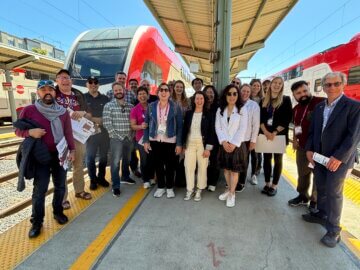
At the 2025 APTA Rail Conference, transportation professionals from around the world were able to ride the newly electrified Caltrain system, which was funded in part by the Authority.
Partnerships and progress were on display as transportation executives from around the globe experienced the high-speed rail project first-hand in two separate tours at the 2025 American Public Transportation Association (APTA) Rail Conference in San Francisco.
On Saturday morning, a tour on transit-oriented development visited the Salesforce Transit Center, including the already-built train box underground, the future terminus of both California High-Speed Rail and Caltrain, as well as the nearly 19 acres of housing, commercial and open spaces around it. This neighborhood has been transformed through an ambitious planning and development effort called the Transbay Program.
The tours were led by Adam Van de Water, Executive Director of the Transbay Joint Powers Authority (TJPA), which owns and operates the Transit Center, the future home of high-speed rail in San Francisco.
Van de Water called it “one of the most successful transit-oriented developments in the country.” He explained, “Over the last two decades, the TJPA and its partners have transformed acres of parking lots and freeway ramps into the most exciting new neighborhood in San Francisco with nine transit operators, millions of square feet of new development, now home to over 15,000 new residents.”
Later that day, 25 conference attendees rode the newly electrified Caltrain system and visited the multimodal Salesforce Transit Center, the future northern terminus for high-speed rail. The Authority’s investment of more than $700 million for the electrification of the Caltrain corridor helped pay for this project and prepare the corridor for future high-speed rail service.
Sherri Bullock, the Director of the Caltrain Modernization Program, described the benefits. “Electrification enables us to safely share infrastructure. It increases corridor capacity by enabling faster acceleration, shorter dwell times, and higher service frequencies,” while reducing emissions, she explained. “This marks a major milestone not only for Caltrain, but for the future of integrated, modern rail throughout California.”
The tour started at 4th and King Station and rode to Millbrae Station. Highlights included four historic, century-old tunnels in San Francisco, and the proposed Northern California Light Maintenance Facility in Brisbane. Guests heard about the different kinds of crossings, the complex infrastructure surrounding San Francisco International Airport, and the new housing being built around the train stations. John Litzinger from the firm HNTB contributed his technical expertise to the briefings and discussion.
| OUTREACH UPDATES |
Transportation Students Tour High-Speed Rail Highlights
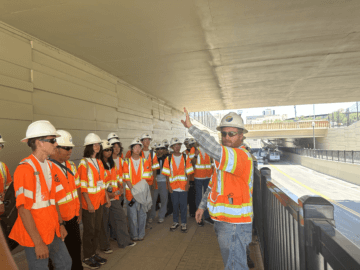
In the Central Valley, MiSTA students were able to see high-speed rail structures up close on a construction tour led by Authority staff.
“Where was the record set for the fastest high-speed rail time, at nearly 357 miles per hour?” Without delay, several Mineta Summer Transportation Academy (MiSTA) students supplied the answer: “France: the TGV.”
It’s evident the high schoolers — future transportation leaders — have a passion for high-speed rail as they take in the structures of California’s High-Speed Rail project being built across in the Central Valley.
The trip is a part of a three-week, hands-on program for students with an interest in transportation and related fields at San Jose State University’s Mineta Transportation Institute (MTI). A key feature of MiSTA is behind-the-scenes tours of transportation infrastructure and systems like airports and rail stations.
Daniel Heine from the German rail operator Deustche Bahn (DB) kicked off the Central Valley construction tour with a briefing for the 28 students on a bus ride from San José on July 16. DB is the Early Train Operator for the Authority, with responsibilities including strategic train service planning and system integration. Heine covered technical and policy issues for the students. He stressed the safety of rail operations and the environmental benefits of high-speed rail.
Authority Public Information Officer Augie Blancas led the tour and briefing on the ground in Fresno, reminding students, “We will be going to an active construction site, and safety is always our top priority.” Safety briefings were repeated before each stop.
The students then went down to the Tulare Street Underpass that runs below central Fresno before visiting the top of the Cedar Viaduct to the southeast. At the underpass, Authority staff briefed the students on the techniques used in concrete construction and the importance of drainage for underground structures.
The tour highlight was climbing up the Cedar Viaduct, which spans more than 3,700 feet and is more than 40 feet wide. Briefings covered the site’s construction history and design details, as well as safety practices for climbing such a massive piece of infrastructure.
The 2025 academy was funded by FRA’s Consolidated Rail Infrastructure and Safety Improvements (CRISI) grant program, which is dedicated to improving the safety, efficiency, and reliability of intercity passenger and freight rail.
“We want these students to learn directly from the engineers, and planners, and outreach and communications staff about everything that is involved in building a mega infrastructure project,” said Alverina Weinardy, MTI Director of Operations. “By giving them a behind-the-scenes look at the high-speed rail progress, we’re inspiring the next generation to pursue transportation careers that shape how we move — and how we live.
Southern California Outreach Recap
K12 Foothill Consortium High School Intern Student Projects Onboarding Tour
This summer, the Southern California team welcomed the K12 Foothill Consortium High School interns from the Charter Oak, Monrovia, Duarte, and Azusa Unified High School Districts for their inaugural onboarding tour with the Authority as part of their summer student projects.
Their journey began with a tour at Los Angeles Union Station (LAUS), led by Jared Nigro, COO of the Los Angeles Railroad Heritage Foundation, where he shared the station’s rich history and its role in California’s rail legacy. Students then had lunch and explored the Authority’s current exhibit at Phillipe the Original, the historic French dip restaurant across from LAUS, to view the display in the train room, while collaborating on the redesign that a student intern designed in collaboration with Authority staff as part of her student project and set to debut in September. The day concluded at the Authority’s Southern California office, where students learned more about the statewide project and the diverse career opportunities. To learn more about these students’ projects, click here.
Los Angeles Public Library Job Fair
This summer, at the Los Angeles Public Library job fair, the SoCal team connected with more than 50 job seekers eager to learn about California’s high-speed rail project. Authority staff provided updates on the project’s progress while discussing career pathways and the opportunities available for those interested in skilled trades. The Authority shared opportunities available through the Central Valley Pre-Apprenticeship Training Program, and attendees were excited to learn more about the future career opportunities in high-speed rail and asked numerous questions about career paths. The event helped build enthusiasm and encouraged the community to learn more about the project and how to prepare to be part of the historic transformation in the state’s transportation landscape.
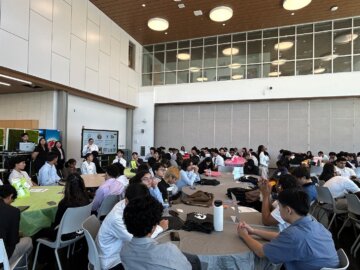
At the Los Angeles Metro TCAP graduation ceremony, students received a presentation on the status of California’s high-speed rail project from Authority staff.
I Will Ride Presentation – Los Angeles Metro Transportation Career Academy (TCAP) Program
At this year’s Los Angeles Metro TCAP graduation ceremony, SoCal Authority staff presented to more than 200 student interns about the future of high-speed rail. It highlighted the project’s impact on transportation, sustainability, and future career opportunities throughout the state.
For the first time in SoCal, a high school student intern presented to the group to share her experience working with SoCal Authority staff this summer while assisting in the redesign at the Phillipe the Original restaurant, which houses the Authority’s current museum exhibit in the train room. This allowed the students to learn more about this unique opportunity through her experience while asking Authority staff questions about planning, construction, and career readiness. The TCAP interns were excited to learn more about the project and the students’ experience and expressed their enthusiasm for the future of high-speed rail.
This project was made possible through the Authority’s I Will Ride’s student engagement program, which creates pathways for students to explore careers in passenger rail transportation and facilitates activities that bridge education and workforce readiness. Check out the exhibit at Phillipe’s!



